|
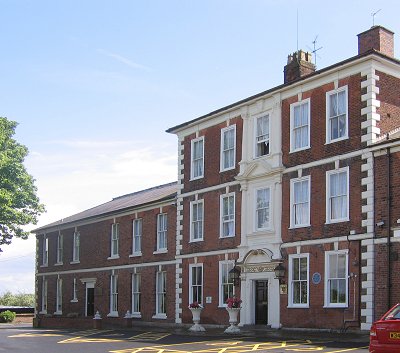
Listing: House, later Roman Catholic School, now hotel. 1705;
additions of later C18; alterations including windows, c.1836; C20 alterations
and additions. Early Georgian style. One of a number of early C18 houses in the
Borough; important as an early Catholic school, founded by Bishop Richard
Challoner, with connections with many notable Catholics of the C18 and C19,
including John Kemble, actor, and Bishop John Milner.
Pevsner: It looks late C17 but may be very conservative C18 design.
Brick of five bays and three storeys. In the middle a frontispiece of three
tiers, with attached columns, Tuscan, Ionic, Corinthian. Above the doorway a
steep open triangular one. The carvings of the frieze above the doorway look
positively Jacobean.
Plaque: John Philip Kemble, 1757-1823, actor,
attended Sedgely Park School, 1767-1771, formerly on this site;
debut in acting, Wolverhampton, 1776.
Comment: originally this house was in the countryside between
Wolverhampton and Sedgley, but Wolverhampton's expansion washed up against its
boundaries in the 1930s in the form of the Goldthorn Estate. The buildings
are now the Ramada Park Hall Hotel. The gardens at the front are now under
a large car park. The rear of the building and the wing to the right of the
picture above are all modern. The wing to the left in the picture above
seems to be Victorian, at least as far the the doorway; beyond that the three
bays are recent, built to match.
|
The main door with its
remarkable decoration. You can see why Pevsner
favoured an early date for the building. Where
the statutory list got its dates from is not known.
In the frieze above the
door that must be an angel in the middle; but are
those the masks of Tragedy and Comedy on each side?
If so, why? This must long pre-date Kemble's
stay here. |
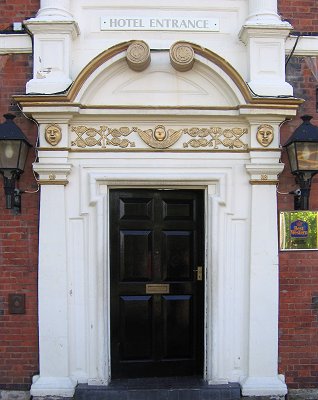 |
The major source of information on the early days of this
building is "The History of Sedgley Park School" by F. C.
Husenbeth DD, published by Richardson & Son, London, in 1856.
Husenbeth had been a pupil at the school, and his information
seems reliable. The book presents a detailed picture of
life at the school, including a detailed account of its
buildings.
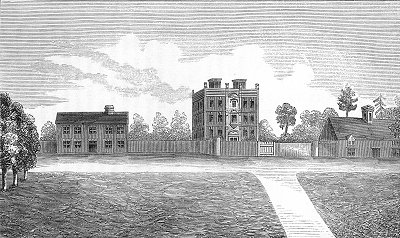 |
Park Hall in 1763, with
"The Lantern" in the centre and its detached service
buildings to each side. |
The house was built as the family residence
of the family of Dudley and Ward. Husenbeth describes
it as being "built in the style of Inigo Jones" - a rather
doubtful proposition. He says, probably more
accurately, that the house is called Sedgley Park from the
parish in which it stands "but in the neighbourhood has been
much more commonly called the Park Hall". He notes
that the building had many windows on every side which, when
lit, gave rise to its local nick name, The Lantern. To
add to the confusion of names this central building was
known, in the school, as The High House. A peculiarity
of the building was that the "usual offices" were in two
buildings, (shown in the drawing above), detached from the
main house. It would have been more usual to have
connected them by a low wing or, at least, a colonnade; but
it seems that the Dudley's food came from the kitchen to the
dining room through wind and rain.
In 1757 the sixth Baron Ward inherited the
title and set about moving out, to Himley Hall a few miles
to the south. In 1763he let the premises to Bishop
Challoner for use as a Catholic school - at a time when such
schools were still illegal (but mostly tolerated and soon to
be legalised). Until then British Catholioc children
had been educated at English colleges and convents abroad,
such as Douai, St. Omer, Vallodolid, Lisbon. So,
subject to a few doubtful cases of small, primary schools,
Park Hall founded the first post-Reformation Catholic school
in the country.
| Park Hall in about
1801 with additions made by the school. |
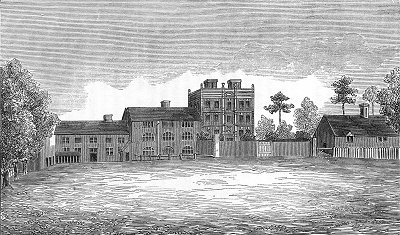 |
The school flourished, with many staff who
were distinguished Catholics, and many pupils, by no means
all of whom were destined for Holy Orders but many of whom
did go on to become distinguished Catholic priests.
With the number of pupils usually being a little over 100,
many of whom were borders, and the large number of staff it
seemed necessary to employ to look after them, the house
soon needed enlargement and additions and rebuildings went
on throughout the life of the school at Park Hall.
|
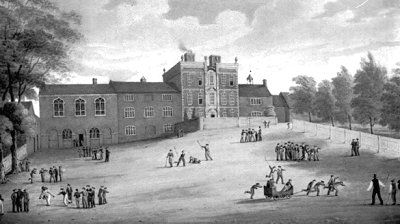 |
The
buildings in about 1837, showing the play area,
known as "The Bounds". Husenbeth gives
many details of the games and recreations of the
boys. |
The school seems to have been conducted
along lines unlike those of the then growing public schools.
There seems to have been no prefectorial system, the masters
lived in and supervised the boys at all times. It
might have surprised Arnold and he might have learnt from
it.
In 1857 the then Earl of Dudley refused to
grant anything other than a yearly tenancy. The school
decided to move and finally quit Park Hall for Cotton Hall,
on the Staffordshire Moorlands, in August 1868. The
school continued there until it closed in 1873.
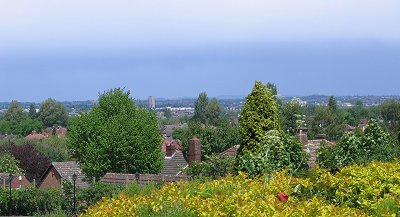
The Hall lies on a ridge and one
could see Wolverhampton, about two miles to the north, and
Sedgley about one mile to the south. Then the view
would have been mainly of fields, woods and commons. Later
it become a scene of industry. Now it is mainly of
suburbia.

|